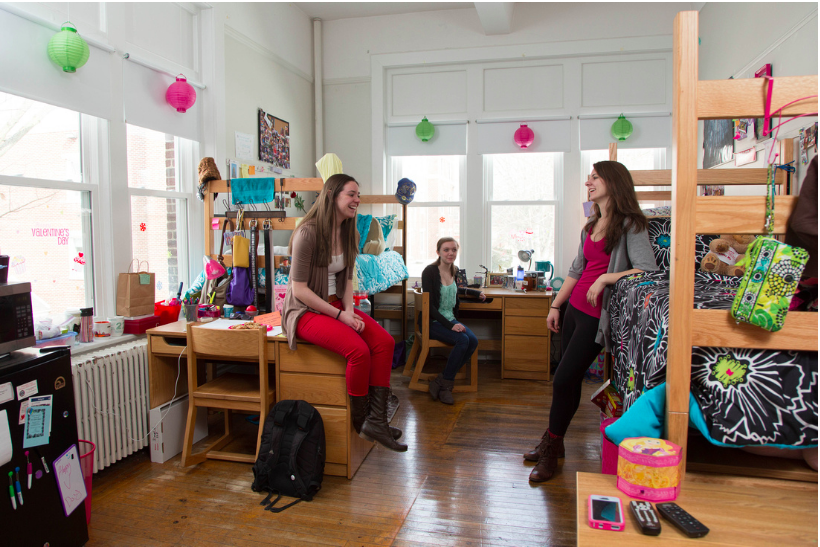Students were asked for their thoughts on converting Brown Hall, the college’s only all-female residence hall, into a co-ed dorm by a digital survey emailed out on Monday, Sept. 24 with the intention of making the freshmen dorms more gender-inclusive.
Inquiries like the ones sent out on Monday occur every few years. The results of the survey will not affect housing arrangements for this academic year, and any changes would take place no earlier than the fall of 2019.
Dean of Students Allison Gulati and Assistant Dean of Students and Director of Housing & Residence Life Courtney Stephens are currently collecting student input on the topic.
“Brown Hall has been designated as a female building for decades. Like many practices, this has some benefits and barriers,” said Gulati in the email. “Over the next year, we will be discussing this practice to make a determination about how students will be housed in Brown Hall for future years, and if it will continue to be designated as all female.”
“For years, students have inquired about the ability to live in Brown, regardless of identity,” said Stephens. “[Brown] is the only residence hall that is not in line with our gender inclusive policies. For instance, there are no facilities with showers to support non-female gendered bathrooms.”
The College introduced gender-neutral housing in the lottery for the 2011-2012 school year, which was the first year students of different gender identities could share a double. In 2015, the signage of 17 bathrooms was changed to gender neutral. Last year there was talk of increasing that number. Currently, each dorm except for Brown and the Courts contains at least one gender-neutral bathroom. According to the Housing and Residence life webpage on gender neutral housing, Students should use the bathroom on their floor of the gender that they identify with.
“Currently, we have some [gender-inclusive] options, particularly for upper class students, but we hope to expand the options for everyone,” said Gulati, “and specifically to consider expanding gender inclusive options for first year students.”
Calista Bender ‘20, who lived in a triple in Brown Hall her freshman year, agreed that it was a quieter, more comfortable dorm than her more recent residences in Martin Luther and Taylor hall. But in the long run Bender hasn’t seen any difference.
“I don’t think it impacted me at all, living in a dorm that was all-female. I don’t think that it made me feel any different than when I lived in ML with guys on the floor.” said Bender. “So to me having an all female dorm is segregating to females, and the opposite of making everything gender neutral.”
Laura Boll ‘20 also lived in Brown Hall her freshman year, but switched to Walz in the spring semester. She liked Walz equally as much as Brown, but recognized the importance of an all-female space to other women on campus.
“It’s nice to have an all-girl’s option for people who want that. I don’t know why we don’t have an all boys option, though… I guess if you’re trying to get fairness,” said Boll. “I know a lot of girls who want an all-girl’s space.”
Brown has remained a women’s dorm since the College adopted coeducation in 1957, according to research provided by Sabrina Roth ‘20, for the Muhlenberg Memories project. The building was constructed in 1916 as an all-men’s preparatory school, then served as a dorm for veteran students during WWII. It was renamed in 1961 after Dr. John Brown, the head of the English department. In 2016, the temporary dormitories known as The Courts became the second all-women’s dorm on campus, acting as overflow from an over-crowded Brown.
Roth named her documentary on the history of Brown Hall “A Sanctuary for Women.”
“I think there’s something to be said about the fact that it’s an all-women’s dorm now and the history behind that,” said Roth, who has not lived in Brown Hall.
“I’m not sure everyone knows the history of the building,” Roth continued, “but it is important to note that it is a landmark for women at Muhlenberg and all around, because it was the first class of women at this college.”
“That was the only place they had for themselves on campus at a time when it was all pretty new,” Roth said.
“[In Brown] there’s a sense of comfort; I didn’t have to worry about what I was wearing while I was walking through the halls, and everything was clean,” said one resident Roth interviewed and quoted in her documentary.
The survey sent to students on Monday reevaluates the need for an all-female dorm on campus.
Survey questions ask students to rank on a 1-5 scale of strongly agree to strongly disagree the importance of an all-female residence hall on campus, whether or not an all-female dorm limits housing for male students, and whether or not it poses a barrier for transgender and non-binary students. The final question asks “If Brown Hall was available to all students, I would want to live there.”
To receive a new survey contact Nicole Hammel, Director of Institutional Research at nicolehammel@muhlenberg.edu.
Students who have any questions about the proposed policy can reach out to Stephens at courtneystephens@muhlenberg.edu.
Chloe Gravereaux is the current Editor-in-Chief of the Muhlenberg Weekly, to which she has contributed since her freshman year. She dabbles in all forms of verbal and visual art, specializing in journalism and short fiction. Her unrivaled color coordination skills and investment in the dollar section of Target have earned her the nickname "Office Mom."






















